Introduction
Blueberry (Vaccinium corymbosum L.) belongs to the Ericaceae family and is a crop of world importance that, in recent years, has shown an average annual growth of 3,000 ha. In 2016, Mexico ranked fourth with a production of 18,031 t, of which 17,345 t were exported with a commercial value of 187.9 million dollars (United Nations Food and Agriculture Organization [FAO], 2020). Given the importance that this crop consistently gains, there is a need to satisfy the market requirement in terms of quality and quantity. Hydroponic systems are presented as an interesting alternative since they allow better nutrition management, in addition to reducing the loss of nutrients to the environment (Voogt et al., 2014).
In the productive reconversion process in recent years in Mexico, the adoption of new crops and production technologies has been chosen, particularly that of strawberries under conditions of protected agriculture (Álvarez-Bravo et al., 2019). Through these systems, it is possible to achieve higher yields, better quality and safety of the fruits, higher control of the climate and nutrient supply, uniform and early production, less space necessary to produce, and better control of pathogens and saving of agrochemicals, in addition to high planting density, at least initially (Voogt et al., 2014).
Most of the cultivated species of the genus Vaccinium require for their optimal development, an acidic pH in the growth medium, and high availability of iron (Poonnachit & Darnell, 2004). Most of the surface established with this crop is in soil, and the conditions it demands are hardly met.
The studies of mineral nutrition in blueberry, mostly, refer to nitrogenous nutrition, regarding the ionic form of preference for its absorption (NO3 - and NH4+). However, the results are contradictory, as some mention that the ammoniacal form is better (Poonnachit & Darnell, 2004), while others indicate that the nitric form is the best (Crisóstomo et al., 2014). Some studies show that fertilization significantly affects fruit quality (Pavlis, 2006), which is determined by fruit size, color, flavor, and firmness, among other attributes. The content of potassium, fiber, and antioxidants such as vitamins A and C, give this fruit high nutritional and economic value (Bello et al., 2012).
Blueberry is sensitive to the salinity of the medium, and an electrical conductivity (EC) higher than 1.5 dS/m has been reported to damage the root system, leaves, and fruit production (Machado et al., 2014). However, there is insufficient evidence of the management of the concentration of the nutrient solution in hydroponic systems by proportionally increasing the concentration of ions present.
Accordingly, the aim of the study was to determine the foliar nutritional concentration, production, and quality of blueberry cv. Biloxi, as a function of the nutritive solution.
Materials and methods
The study was carried out from June 2017 to June 2018 in Unidad Académica de Agricultura [Academic Unit of Agriculture] in Xalisco, Nayarit state, Mexico (21°25′ N, 104°53′ W, and at an altitude of 958 m above the sea level), in a semi-tunnel type greenhouse with transparent plastic cover. The greenhouse did not have climate control but had passive zenithal and lateral ventilation. During the crop cycle, the minimum temperature was 17°C, the maximum temperature was 42°C, and the relative humidity was 70%.
Plant material
One-year-old blueberry cv. Biloxi plants propagated by in vitro culture that were purchased from the company Viveros Toluquilla in Tlaquepaque, Jalisco, Mexico, were used. The transplant was carried out in 15 L black polyethylene bags, using as a substrate, red basaltic volcanic rock of particles smaller than 6.0 mm in diameter. The spacing was 2.0 m between rows and 0.50 m between plants.
The irrigation system consisted of four tanks with a capacity of 200 L with 1/2 horsepower electric pumps. The nutrient solution was supplied through 16 mm hoses and 8 Lph drippers. Irrigation was carried out with pulses of one minute every hour, which added up to a total of seven irrigations per day, with a real expenditure of 100 mL plant per irrigation during the first four months after establishment. Subsequently, the irrigations were supplied for one minute every half hour, with a total of 15 to 18 irrigations per day.
Nutritive solution treatments
During the first month, all plants were watered with the universal nutrient solution of Steiner (1984), with an electrical conductivity of 0.5 dS/m and a pH adjusted to 6.0 with sulfuric acid (14N). Then, the adjustments for the different treatments with their corresponding concentrations were made with 0.5, 1.0, 1.5, and 2.0 dS/m. The nutrient solution was modified in the anion ratio, using 15 meq of total nitrogen, of which 25 % was supplied in NH4+ form (table 1). Soluble fertigation grade fertilizers were used: potassium nitrate, calcium nitrate, monopotassium phosphate, potassium sulfate, magnesium sulfate, ammonium sulfate, and a mixture of micronutrients (Micromix®).
Table 1 Nutritional solutions used in blueberry cv. Biloxi

EC = electrical conductivity
Source: Elaborated by the authors
The Ultrasol® Micro Mix, which is a complex of chelated micronutrients, was used as a source of micronutrients at a rate of 0.03 g/L of water.
Experimental design
The experimental design employed was completely randomized with four treatments and five repetitions, and each repetition had four plants, for a total of twenty experimental units.
Evaluated variables
Foliar nutrient concentration in vegetative, flowering and fruiting stages
At each phenological stage, five samples of recently mature, asymptomatic, and damage-free leaves were collected from each treatment. These were washed and dried in an oven with forced air circulation at 70°C for 48 hours. Subsequently, they were ground and digested through a wet process at a rate of 4 mL per sample of 0.5 g of dry matter. The analytical determinations carried out were: N by the Kjeldahl method, K by flammometry, P by colorimetry, and Ca and Mg by atomic absorption spectrophotometry. An extraction was carried out through a wet digestion process, according to the procedures described by Alcántar-González and Sandoval-Villa (1999). For the case of N, a mixture of sulfuric acid with salicylic acid was used, while for P and K, a mixture of nitric acid with perchloric acid was employed. The total N content was established by the semi-micro Kjeldahl method; P was determined by colorimetry with a spectrophotometer (DR2800, Hach®, USA), and K with a flammometer (Flame Photometer 410, Sherwood®, Great Britain).
Fruit production
The harvest index was the color of the fruit completely blue, and free from damage and injury. The fruits that were harvested from each plant were weighed on a Precisa® digital scale every 25 days, from December 10, 2017, to May 30, 2018.
These fruits were classified according to their diameter into four calibers: very small (< 10 mm), small (≥ 10 mm - < 12 mm), medium (≥ 12 mm - < 16 mm), and large (≥ 16 mm), and registering fresh weight as well. The juice was obtained with 300 g of fruit, and the pH and total soluble solids were determined with a potentiometer (Horiba model LAQUAtwin) and a digital refractometer 0-53 % Brix (Atago, model PAL-1). Furthermore, fruit firmness was measured with a digital penetrometer (Meter2u, GY 4) by point deformation on a plane of 1.0 cm in diameter at the two equatorial poles.
Statistical analysis
The data were subjected to analysis of variance and Tukey’s means test (p ≤ 0.05) with the statistical program SAS® (9.0) 2009. A Z standardization was performed to the fruit size values. Regarding the variables °Brix and pH of the fruits, linear regressions were performed to identify the degree of association of the nutrient solutions with such variables.
Results and discussion
The highest foliar concentration of N and K was obtained with the EC of 2.0 dS/m (p ≤ 0.05), while the lowest was found in the treatments with EC of 0.5 and 1.0 dS/m (table 2).
Table 2 Foliar nutritional concentration in blueberry cv. Biloxi in the vegetative stage due to the concentration effect of the modified Steiner nutritive solution
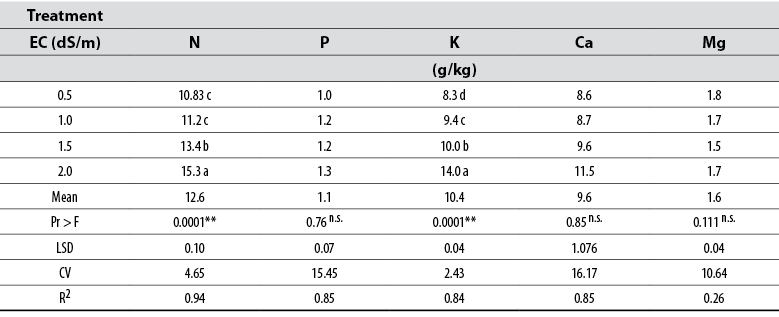
EC = electrical conductivity; Pr > F = probability higher than the calculated F; ** = highly significant difference. Means with the same letter within each column do not differ statistically (Tukey, p ≤ 0.05). n.s. = not significant. LSD = least significant difference; CV = coefficient of variation.
Source: Elaborated by the authors
The concentration of N with 2.0 dS/m is similar to the one reported by Bryla and Strik (2015) for V. corymbosum in a nitrogen fertilization study. Between the foliar concentration of N, P, K and Ca, and the concentration of the nutrient solution (NS), there is a significant correlation (R2) (> 0.84), which indicates that with the NS evaluated, the culture proportionally absorbed these nutrients as the nutritional concentration of the NS increased. In the case of Mg, the degree of association is weak (R2 = 0.26), and there was no statistical difference between treatments; thus, in this phenological stage, the concentration of Mg in NS with 0.5 dS/m is enough to satisfy the need of the crop.
Furthermore, N was the element with the highest concentration in leaves, followed by K, Ca, Mg and P, data that coincide with Rivaneira (2012) and are at the optimum levels for blueberries.
Foliar nutrient concentration in the flowering stage
The highest concentration of N and K were observed with 2.0 dS/m, followed by NS with 1.5 dS/m. The lowest concentration was obtained with the NS of 1.0 and 0.5 dS/m (table 3). The concentrations of P, Ca, and Mg were not affected by the treatments.
Table 3 Foliar nutritional concentration in blueberry cv. Biloxi in the flowering stage due to the concentration effect of the modified Steiner nutritive solution
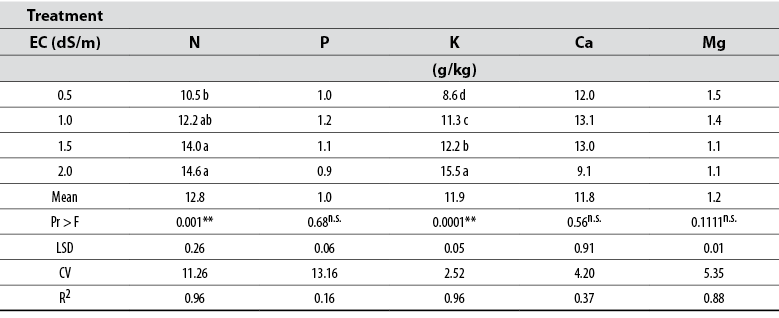
EC = electrical conductivity; Pr > F = probability higher than the calculated F; ** = highly significant difference; n.s. = not significant. Means with the same letter within each column do not differ statistically (Tukey, p ≤ 0.05). LSD = least significant difference; CV = coefficient of variation.
Source: Elaborated by the authors
The concentration of N and K increased proportionally to the concentration of the NS. This behavior can be attributed to the synergism that exists between NO3- and K (Navarro & Navarro, 2014), which leads to efficient absorption of these nutrients, since even the concentration of K indicated by Strik and Vance (2015) was exceeded in some cultivars of V. corymbosum, i.e., from 6.0 to 12.0 g/kg.
No differences were observed in P, Ca, and Mg between treatments; therefore, the nutrient solution with 0.5 dS/m, supplies at this stage the requirements of the crop. In the case of P, it is well known that the crop has effectiveness in its absorption, and this allows it to thrive in acidic soil conditions, which are characterized by having low availability of P. Therefore, in the current study, no significant decrease was observed in its foliar concentration. Strik and Vance (2015) found that the level of foliar P depletion is strong, since, being at a concentration value of 0.40 %, it decreases over time until it reached values below 0.20 % during the fruit production stage.
Foliar nutrient concentration in the fruiting stage
In the fruiting stage, the highest concentration of N, K, and Ca was registered in the solution with an EC of 2.0 dS/m and decreased as the NS was more diluted (table 4).
Table 4 Foliar nutritional concentration in blueberry cv. Biloxi in the fruiting stage due to the concentration effect of the modified Steiner nutritive solution
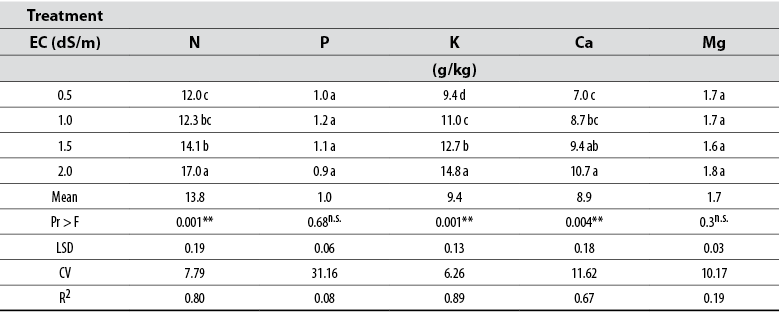
EC = electrical conductivity; Pr > F = probability higher than the calculated F; ** = highly significant difference; n.s. = not significant; means with the same letter within each column do not differ statistically (Tukey, p ≤ 0.05). LSD = least significant difference; CV = coefficient of variation.
Source: Elaborated by the authors
The foliar concentration of N, K, and Ca increased significantly and proportionally with respect to the NS concentration. Potassium is an element that influences fruit yield and quality (Santoyo et al., 2011), so its demand increases during fruiting. In the evaluated NS treatments over time, there was no deficiency level in any of the nutrients, according to Rivaneira (2012). There was a high correlation (R2 = 0.89) between the NS concentration and the K concentration in leaf tissue. This indicates that there is an optimal nutritional replenishment at the leaf tissue level, since, although a large amount of K is being mobilized towards the fruits, the shortage effect was not observed at the leaf level, even though there were significant differences in some nutrients due to the effect of treatments.
It is important to emphasize that, in Vaccinium sp., P is the nutrient that has the most fluctuation; in fact, Strik and Vance (2015) reported a range of 0.40 % at the beginning of fruiting and 0.20 % at the end of fruiting. These fluctuation ranges were not recorded in the current research, which can be attributed to the hydroponic system, which allowed sufficient nutrient supply to the plant.
Fruit production
The accumulated fruit production showed significant differences between treatments (p ≤ 0.05). The treatment in which the highest fruit production was registered was the one with the NS with 1.0 dS/m, followed by treatments 0.5, 1.5, and 2.0 dS/m (table 5).
Table 5 Blueberry production by the effect of the concentration of the modified Steiner nutrient solution
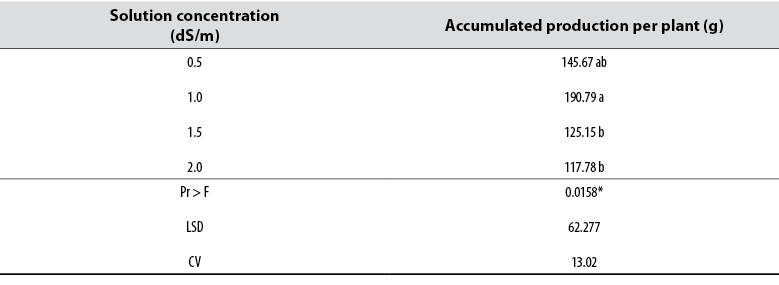
Pr > F = probability higher than the calculated F. Means with the same letter within each column do not differ statistically (Tukey, p ≤ 0.05). LSD = least significant difference; *= significant difference; CV = coefficient of variation.
Source: Elaborated by the authors
Machado et al. (2014) mentioned that electrical conductivity values higher than 1.5 dS/m in the growth medium cause a decrease in the performance of blueberry, which coincides with this research, with the novelty that the effect is maintained even when there is an ionic balance of nutrients.
Fruit caliber
Regarding the fruit size, there was an effect of the treatments on very small, medium, and large-sized fruits. The NS with 0.5 and 1.0 dS/m produced more medium and large fruits. Nonetheless, the lowest amount of very small fruits was obtained in the same treatments. The NS with 1.5 and 2.0 dS/m did not record large fruits (figure 1).
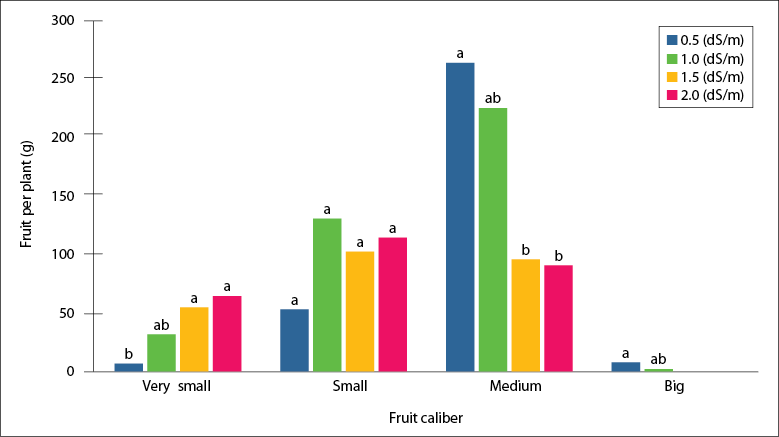
Source: Elaborated by the authors
Figure 1 Effect of the Steiner nutrient solution concentration on the caliber of the blueberry fruit cv. BiloxiAverages with the same letter in each caliber do not differ statistically (Tukey, p ≤ 0.05).
The treatments with higher concentrations of NS obtained a higher quantity of small fruits and did not have large fruits. This can be attributed to the osmotic stress to which the plants were subjected in these treatments. This situation is supported by Mingeau et al. (2001), who verified that, in blueberry plants that are shrubs (high bush) subjected to this type of stress, the impact negatively affects the size of the fruits. A similar case occurred with strawberry that, when subjected to a strong increase in electrical conductivity, its fruit quality expressed in its diameter was strongly decreased (Casierra-Posada & García-Riaño, 2006).
Total soluble solids (TSS), °Brix and pH of fruits
For the concentration of total soluble solids, the analysis of variance did not show significant differences between treatments; however, with the linear regression analysis, an inversely proportional trend was observed. The TSS decreased as the NS concentration increased (figure 2a). In the case of fruit pH, the trend was less acidity as the concentration of the NS increased (figure 2b).
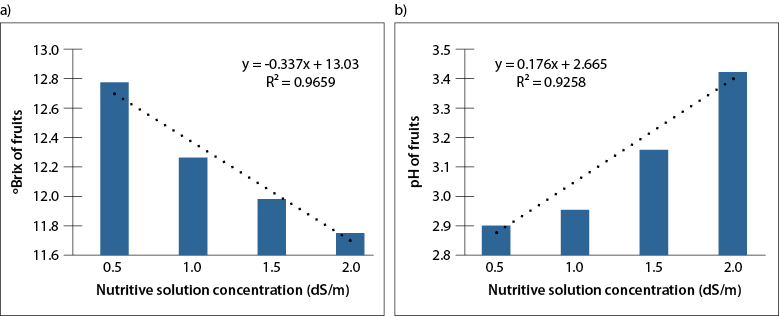
Source: Elaborated by the authors
Figure 2 Effect of the concentration of the Steiner nutritive solution in a) °Brix, and b) pH, of blueberry cv. Biloxi fruits
The fruits harvested in the current research are within the optimal levels reported (10.6 - 13.2 °Brix) for blueberries (Saftner et al., 2008). The TSS content is closely linked to the weight, and, therefore, to the size of the fruit (Cordenunsi et al., 2002). This may explain the reason for these conditions since the fruits of these treatments were mostly the smallest. Fruit pH values in all treatments were in the optimal range (2.5 - 4.0) reported for different blueberry cultivars (Chiabrando et al., 2009).
Fruit firmness
The NS that registered the highest firmness values was 0.50 dS/m, while, in general, the values decreased significantly when the EC was higher than or equal to 1.0 dS/m (table 6).
Table 6 Firmness of the blueberry cv. Biloxi fruits by the effect of the concentration of the modified Steiner nutritional solution
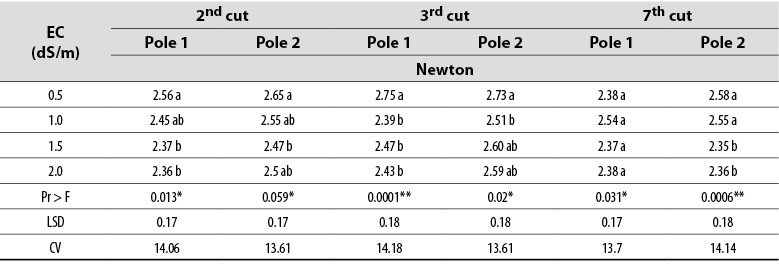
EC = electrical conductivity; Pr > F = probability higher than the calculated F. *=Significant difference; ** = highly significant difference; means with the same letter within each column do not differ statistically (Tukey, p ≤ 0.05); LSD = least significant difference; CV = coefficient of variation
Source: Elaborated by the authors
Treatments with solutions at 0.5 and 1.0 (dS/m) obtained fruits with higher firmness throughout all the cuts. These data are lower than the firmness values reported in other blueberry cultivars, which, on average, are 4.0 Newtons (Rincón et al., 2012).
Conclusions
Blueberry V. corymbosum cv. Biloxi is sensitive to the increase in electrical conductivity. When the EC value is higher than 1.0 dS/m, it affects the growth, production, and quality of the blueberry. In hydroponic systems, a nutrient solution with EC between 0.5 and 1.0 dS/m can be used without affecting fruit yield and quality, nor the levels of foliar nutrient concentration.











 text in
text in 



